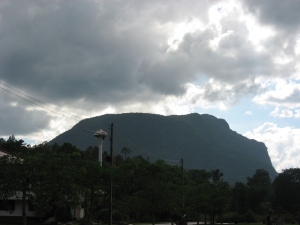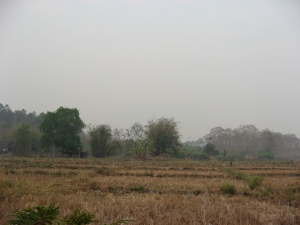When you think of smog, you probably don’t think of a forest or a jungle. More likely, you think of a large city congested with traffic. I would think of the same thing.
Then I moved to Thailand.
In Thailand, smog = February until Songkran (the water festival in April).
This is what I’m taking about. The following photo was taken in June, the beginning of the rainy season. The mountain in the background can be seen quite clearly.
This photo was taken earlier that same year, during the “smog” season. It was taken in generally the same location, a short distance from the building in the first photo. Normally, you would get an even better view of the mountain from here, as the trees aren’t in the way. But you can’t see the mountain at all.
This is the problem that we face year after year. Ou lovely hillsides disappear in the smog.
Here’s how it goes. The farmers harvest their crops in the winter, starting in November and going to January. After that, it’s time to burn the fields to make room for next year’s crops.
Oh yeah, and you can’t grow next year’s crops until June, when the rains come. So the farmers will also burn the underbrush in the surrounding jungle so they can go hunting. So even those who have not burned their fields, perhaps because they’re still growing something, still have to create a fire-break AROUND their fields to protect their crops from the fires coming out of the jungle.
My husband and his brother had to do this last week. They had a crop of garlic and a patch of bamboo they had to protect. Fire from the jungle was headed their way, so they had to drop everything and go out to protect the field.
We failed to do this when we planted avocado trees. We lost over half of them to the burning. We paid good money for those trees.
Of course, we can’t pin it ALL on the farmers. Even those in other occupations contribute to the problem by burning their trash.
Yes, people burn their trash here. If the environmentalists REALLY wanted to make a difference, they’d come here and organize trash pickup. Most places have trash pickup, but a lot of people just don’t bother to put their trash in the designated bins (which look a lot like a witch’s cauldron, sitting on the corner). Even if they do, the dogs get into it and litter is everywhere. There has never been an anti-litter campaign here.
But the smog is considerably bad this time of year. We had to move out of the village primarily so we could use an eletric air filter. My mother-in-law has terrible asthma and the smog nearly killed her last year.
She’s not the only one. A lot of folks wind up in the hospital with respiratory illnesses. Including a lot of kids. And the problem is worse, yes WORSE, if you live in the country. We’re right next to the fields that are getting burned. Of course, being the city isn’t that much better.
Other consequences? Thailand’s main industry is tourism. But no one in their right mind would visit this time of year. Flights wind up getting grounded because the pilot can’t see anything.
So the big question is, what can we do about it? The Thai government has been going around and around the issue for years. They try blaming it on Burma and Laos, but I know better.
I know the farmers. I’m even married to one.
The root of the problem? It’s not the farmers…although it’s close.
A couple years ago, a company set out to purchase the corn chaff from the farmers in Chiang Rai. They then processed it into fertilizer and sold it back to the farmers.
There was considerably less smog in that area that year.
I’m not sure what happened to that program. Trust me, if somebody would buy the corn stalks from the farmers, they would gladly sell it instead of burning it. I suppose the program didn’t have enough support or something.
But now that I’ve been married to a farmer for four years, I think I’ve spotted the underlying problem behind the smog. At least one of them.
The real problem is WATER.
We have a corn field. We can ONLY grow corn in our corn field during the rainy season as it has no WATER. So do all our neighbors.
The fields without water get burned.
There are however, a few fields that DO have water. They are the ones located next to or below a local spring. These fields are used year-round for crops like beans and garlic.
The fields that have water DO NOT GET BURNED!
You always know a field has water because it is green in March. You know the fields without water, as they are black in March.
Think about it. If your field has a steady supply of water, you plant another crop after you harvest. You are also more inclined to grow a crop that does not require burning, such as beans or peanuts or garlic. Farmers are forced to grow corn because it’s one of the only crops that will grow within the confines of the rainy season. Farmers with water in their fields can grow something else.
By the way, if your field has water, you are working year-round. This means you do not have time to go out hunting, which means you do go out to burn the underbrush in the jungle for this purpose. At least, you’re less likley to. You do, however, still need to burn around your field if one of your neighbors decides to do this.
Perhaps it’s not that simple, but maybe it is. All we need to do is get water to the fields that don’t have it. If all the fields have water, more than likely the amount of burning would go down.
Now it’s more of a physics problem: How do you get water to go UPHILL?
A little explanation here. Northern Thailand is populated by mountain farmers. The fields are on the sides of the mountains, usually ABOVE the nearest water source. Hence why they can only grow crops during the rainy season, from June to October. This severely limits what they can grow and most of the people in our area grow corn.
Most of our neighbors get very little money for their corn. My brother-in-law barely broke event this year with his corn.
My husband is currently working on a water pump he saw on YouTube. It uses a vacuum of air to pump water uphill without using any outside power source. If he gets it to work (and I pray that he does), we may be on to something. My brother-in-law would be able to pump water to his corn field and (gasp) GROW SOMETHING OTHER THAN CORN! We could also water our remaining avocado trees, which are in this same corn field.
A businessman has also been visiting our area from Singapore. He has specific crops that we can grow for him and his company will buy them back from us, with a set minimum price. A great deal. Catch is, the crops his company wants REQUIRE WATER!
So really, the solution to the smog problem in Thailand? Get water to the fields! Forget passing out free surgical masks (which is what the government does now). Why not help the farmers get water to their fields? A field that is WET is far less likely to catch on fire.



April 2, 2014 at 3:14 pm
What a clear explanation of a complex problem–as most environmental issues are–you have written. It certainly increased my understanding of a place I know little about. Thank you.
April 4, 2014 at 11:25 am
good post and blog……….
April 16, 2014 at 11:53 pm
This was really interesting, thank you for teaching me something new as I love learning things. Funnily as an information professional/librarian/researcher I immediately wanted to go and do research on irrigation. It sounds like your hubby has a good idea going, I would love to know if he succeeds.
Having not done any research what I am about to say does come from a somewhat ignorant place, but I was just wondering whether you have looked at rainwater tanks to collect water during the rain season for use in the dry? The water can be hand distributed or you could use a drip line system to distribute it.
It might be worth looking at water systems used in the Australian Outback, it gets so dry it is not funny and is often in a state of drought, but they continue to grow crops. This might not be helpful to you, but I hope it is.
April 17, 2014 at 1:29 am
Thank you. Yes, we have heard of using holding tanks to collect water in the rainy season. The main concern is if it would be enough water for everyone. The fields around the water tanks belong to different farmers, who grow different crops, and need different amounts of water. We think a pump would be better to make sure the water supply doesn’t run out. We recently found a place that sells these pumps and they will give us a free survey of the area to see if it would work for our village. They don’t come cheap though, so don’t be surprised if I start posting about a fundraiser!
April 17, 2014 at 3:31 am
As I was writing about the tanks I was thinking that they may not hold enough to crop throughout the seasons. The pump sounds fantastic, I really hope it works out that it is suitable and affordable – long shot hoping for both I know, but a little hope never hurt anyone 🙂